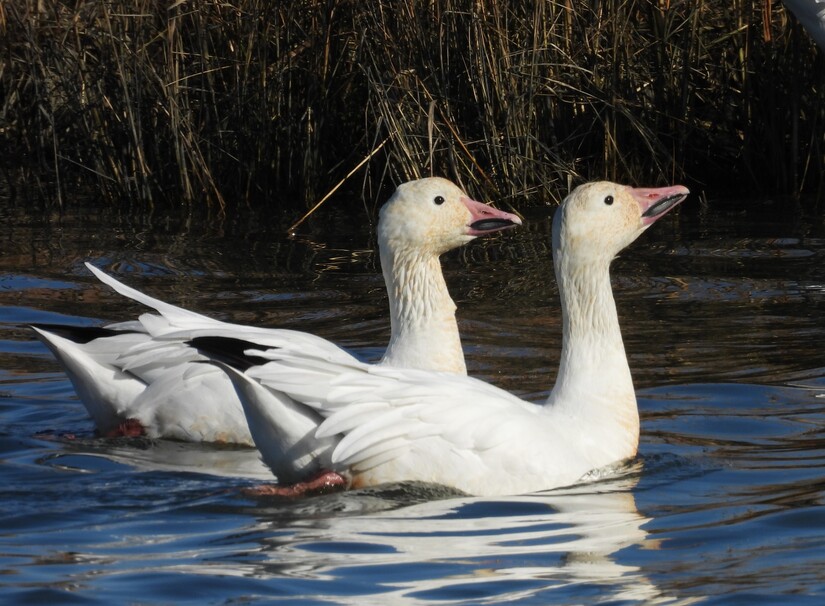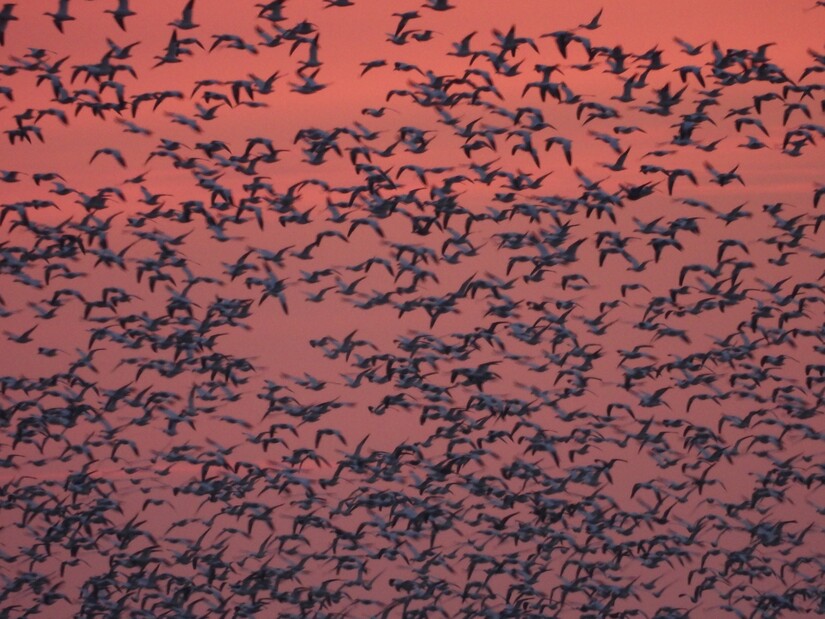Image

by Mike Strzelecki
Waterfowl birders celebrate the coming of November, as it marks the return of ducks and geese to the mid-Atlantic region. They arrive from their Arctic wintering grounds and make their seasonal homes in the ponds, lakes, and coastal estuaries throughout the region. No species of waterfowl makes a grander entrance than snow geese. They arrive in immense formations by the thousands, if not tens of thousands. They honk and squawk and create an aerial commotion.

Most folks are aware of Canada geese. They too trace the same migration route as the snow geese, except more and more are becoming habituated and stay year-round near human developments. They have become nuisances on golf courses and in local parks and housing development.
Snow geese almost always migrate. If you see one in summer in this area, it is probably injured and cannot fly. They steer clear of human interaction. Snow geese appear to be pure white, although when in flight, a black wing tip appears. They are a bit smaller than Canada geese. Some snow geese exhibit a genetic variation that makes them appear almost blue. In the picture below, you can see two blue-morph snow geese feeding with the traditional white ones.

Snow geese generally breed in summers in the far north reaches of Canada, on barren and harsh stretches of tundra. They return to their more temperate feeding grounds, including those in the mid-Atlantic region, in winter. They stay in tight flocks, up to tens of thousands of geese. They sleep in open water - on large lakes and bays - out of reach of their land-lubbing predators like coyotes and foxes. At times, large rafts of thousands of snow geese can be seen floating offshore, appearing like a white sand isle. I have seen these frequently along the Delaware beaches and in the Delaware Bay.
Every morning, the snow geese move inland to winterized farmland, where they feed on plant materials - soft grasses, roots, weeds, sedges, leaves. Young snow geese may ingest larvae and grubs, but adults are vegetarian.
My wife and I had the privilege this year of happening upon an estimated 15,000 snow geese spread across three farm fields, near Milford, Delaware. Most were grounded, rooting in the fields for soft plants. They were both at ease, not minding our presence, yet in a state of high alert scanning for predators.
A mature bald eagle appeared low over the canopy of an adjoining wooded lot, probably sensing an easy meal. An eagle can make quick work of a goose. A maelstrom ensued. 15,000 snow geese lifted off the ground in a deafening din, and began swirling like a tornado to fend off the predator. My wife and I were stuck in the middle of the whirlwind of birds. They swirled and roiled, and tightened around us. Small groups of snow geese broke off every so often and disappeared over the horizon. This continued for about 15 minutes, until the last snow goose turned off the light and disappeared over the trees. Even the most experienced birders consider this a lifetime event. Here are a few images from that encounter.





Large flocks of snow geese can be seen flying over the Boyertown area on their migration in late winter (late February through late March), and less commonly in fall. At times, they will descend on farm fields outside of town for feeding breaks. This past March, I saw about 5,000 snow geese bouncing around a farm field near the Yellow House Hotel. The Boyertown area serves as a waystation for their migration.
If you want to be assured of seeing large numbers of snow geese, the best semi-local place to go is the Middle Creek Wildlife Management Area, located between Reading and Lancaster. Up to 200,000 snow geese can be seen there at one time, peaking around early March. Do not forget your camera. Call ahead to see if snow geese are being seen before making the drive.
Snow geese are often seen in Northampton County, north of Allentown. They sometimes winter-over in this area, and can be observed from December through March. They are attracted to the many quarries in the area, but can often be seen feeding in spectacular numbers around adjoining fields. Sometimes the best way to locate these massive flocks of snow geese is to keep an eye peeled upwards and watch for the huge formations moving to and from feeding grounds. The reward of seeing a flock of snow geese is worth the effort in finding them.
* Mike Strzelecki is a freelance travel and outdoor writer, and 1981 graduate of Boyertown Area Senior High School. He writes from his house in Baltimore, Maryland. In his spare time, he joins his wife on adventures around the country observing and photographing birds.